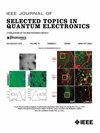Design and Fabrication of Orthogonal Lattice Waveguide With Partial Air Cladding Layers for Circular Defect in 2-Dimensional Photonic Crystal Laser Diode
IF 4.3
2区 工程技术
Q1 ENGINEERING, ELECTRICAL & ELECTRONIC
IEEE Journal of Selected Topics in Quantum Electronics
Pub Date : 2024-12-17
DOI:10.1109/JSTQE.2024.3519611
引用次数: 0
Abstract
Circular defect in 2-dimensional photonic crystal (CirD) microcavities hold great promise for wavelength division multiplexing (WDM), allowing intra-chip optical communications. This paper proposes and explores a structure with air cladding layers only in the orthogonal lattice waveguide (OLW) region to achieve a wide bandwidth of over 20 nm and the high output power required for WDM. Band calculations confirmed a wider bandwidth in the air cladding structure than in the AlOx cladding. Furthermore, 3-dimensional finite-difference time-domain simulations reveal approximately five times higher output compared to conventional structures. Experiments were conducted to fabricate the OLW structure with air cladding layers. Optimization of the etching conditions using buffered hydrogen fluoride etchant successfully removed the AlOx cladding layers and achieved the desired structure. The output lights from the fabricated samples were measured under photo-pumping excitations, confirming increased output intensity due to the air cladding structure. These results demonstrate significant potential for the application of CirD lasers for WDM integrated devices.求助全文
约1分钟内获得全文
求助全文
来源期刊

IEEE Journal of Selected Topics in Quantum Electronics
工程技术-工程:电子与电气
CiteScore
10.60
自引率
2.00%
发文量
212
审稿时长
3 months
期刊介绍:
Papers published in the IEEE Journal of Selected Topics in Quantum Electronics fall within the broad field of science and technology of quantum electronics of a device, subsystem, or system-oriented nature. Each issue is devoted to a specific topic within this broad spectrum. Announcements of the topical areas planned for future issues, along with deadlines for receipt of manuscripts, are published in this Journal and in the IEEE Journal of Quantum Electronics. Generally, the scope of manuscripts appropriate to this Journal is the same as that for the IEEE Journal of Quantum Electronics. Manuscripts are published that report original theoretical and/or experimental research results that advance the scientific and technological base of quantum electronics devices, systems, or applications. The Journal is dedicated toward publishing research results that advance the state of the art or add to the understanding of the generation, amplification, modulation, detection, waveguiding, or propagation characteristics of coherent electromagnetic radiation having sub-millimeter and shorter wavelengths. In order to be suitable for publication in this Journal, the content of manuscripts concerned with subject-related research must have a potential impact on advancing the technological base of quantum electronic devices, systems, and/or applications. Potential authors of subject-related research have the responsibility of pointing out this potential impact. System-oriented manuscripts must be concerned with systems that perform a function previously unavailable or that outperform previously established systems that did not use quantum electronic components or concepts. Tutorial and review papers are by invitation only.
 求助内容:
求助内容: 应助结果提醒方式:
应助结果提醒方式:


